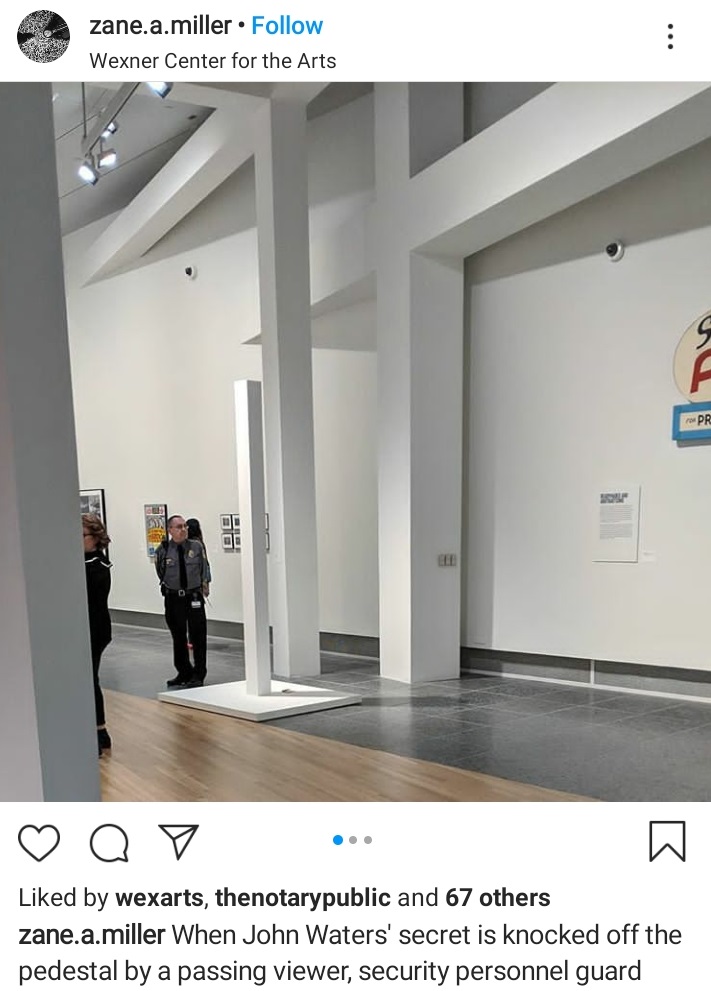1990: MICA-TV’s The Inbetween, in New Works for New Spaces: Into the Nineties
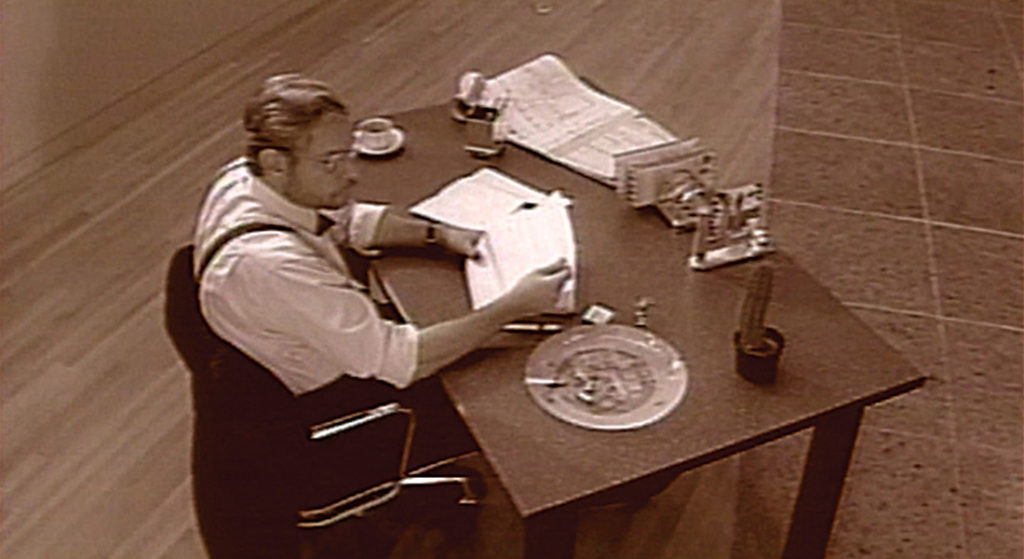
The Wex often creates its own moments of self-reflection, looking back on earlier exhibitions as it looks forward to the new. In September 2019, such a moment occurred when one of the earliest works – The Inbetween by Carole Ann Klonarides and Michael Owen (aka MICA-TV) – was screened in The Box. To accompany this screening, Curator of the Film/Video Studio, Jennifer Lange wrote a short essay on the Wex’s website (click the image below to read it).
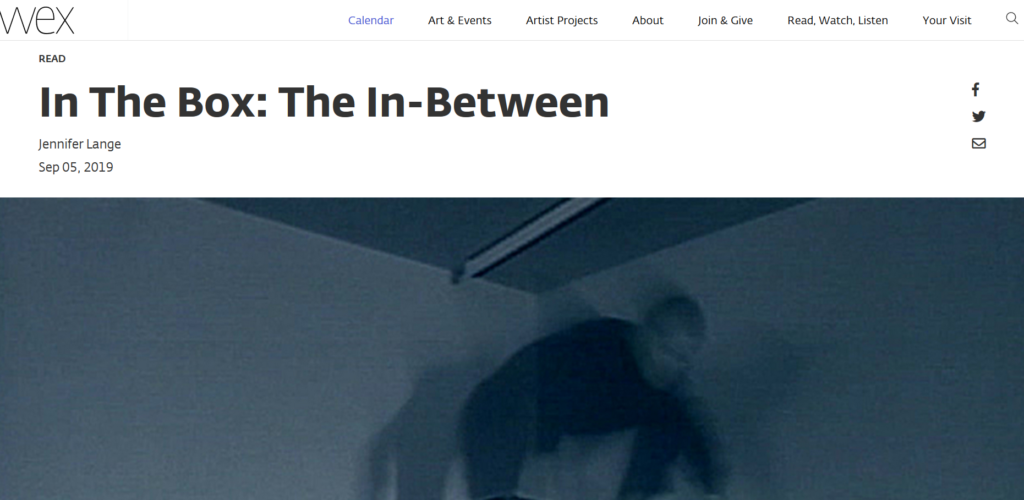
Lange’s essay ends as follows:
The camera moves through the empty space as if driven by the building’s own internal force, while characters appear and disappear as though they are apparitions (or perhaps golems sprung from the building itself). Much like the Wex, Klonarides and Owen’s film is grounded in a specific historical moment, yet simultaneously exists beyond time.
One of these empty spaces was our very own galley B – here’s a production shot of the video included in the catalog Breakthroughs: Avant-Garde Artists in Europe and America, 1950-1990.
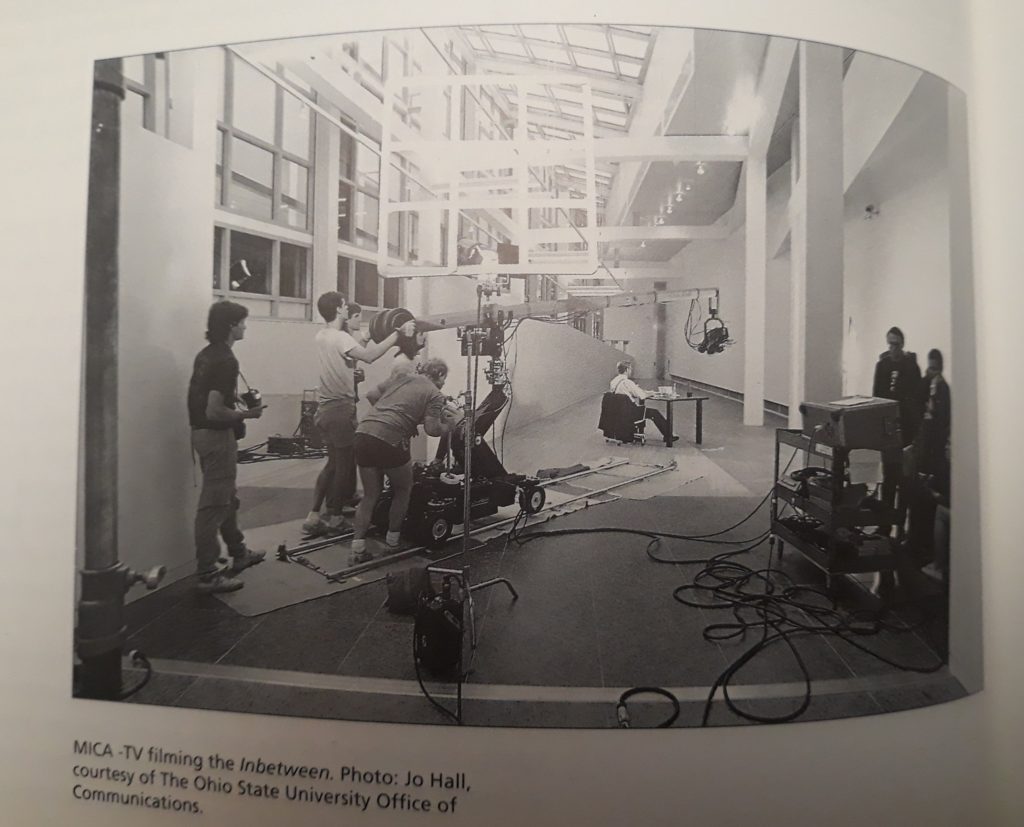
During her essay, Lange quotes from the interview with Lonarides and Owen, also included in the catalog. Towards the end of the interview, the interviewer (former Wex curator Sarah Rogers) asks:
At this point, given that you’re still in the process/idea phase, what is your fantasy of what the project will end up being? […] Your piece, probably unlike anyone else’s in the show, will still be able to exist in its completeness after the show is over.

The show has now been over for 40 years and Klonarides’ response speaks to that passing of time.
[L]ike everyone else, we’re still dependent upon context and an audience. And, as long as the building is received and talked about, the tape will have its own life but be enriched by that experience.
As we continue to ‘talk about’ gallery B here on the gallery B side, even when the Wex is closed during the COVID-19 pandemic, there are still opportunities for us to receive and enrich our experiences of this special place.
For more about MICA-TV and The Inbetween, visit Electronic Arts Intermix.
1990: Ann Hamilton’s dominion, in New Works for New Spaces: Into the Nineties

The above photo confused me no end and then I realized that it was a flipped image since the ceiling slanting upwards is created to contrast with the ramp sloping downwards. Here is another photograph (both from Ann Hamilton’s Studio website – click the images for link – which is from angle that made me less disorientated. As is often the case with gallery B, the flooring and the columns are vital markers for orientation (even if the wall along the ramp is transformed, as it often is)!
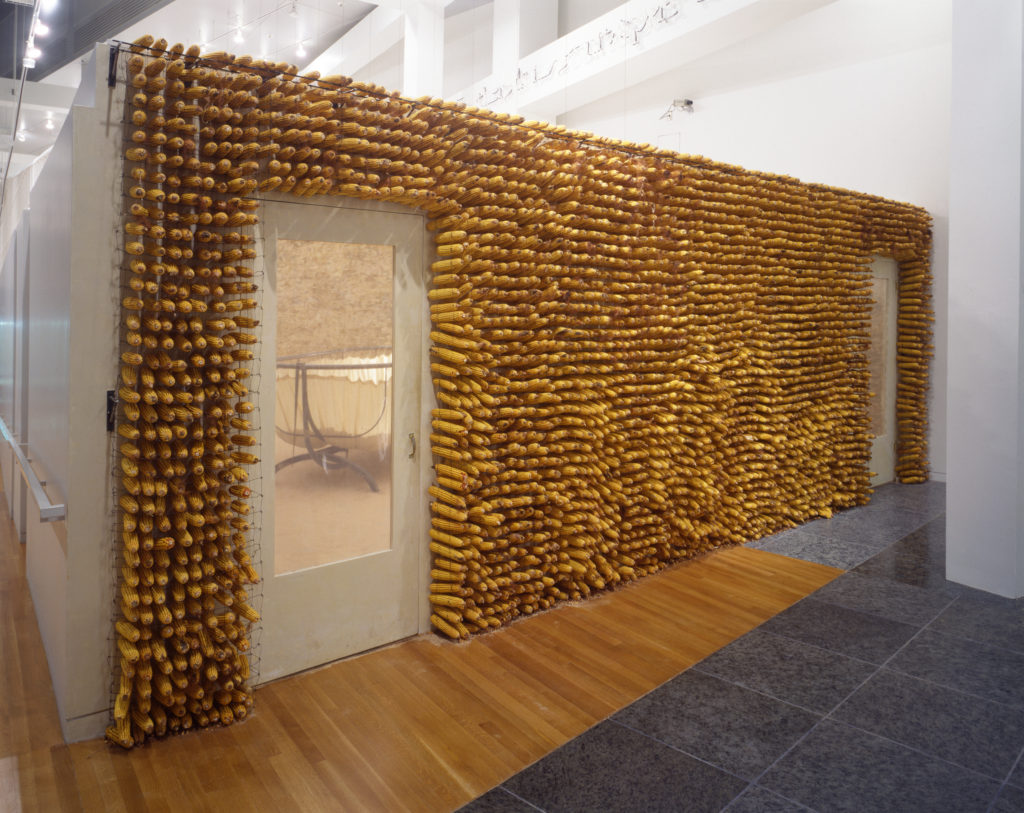
Here is an internal photo so you can see that the narrowed entrance to gallery B (behind where the performer is sitting) facing the top of the ramp with the two doors.
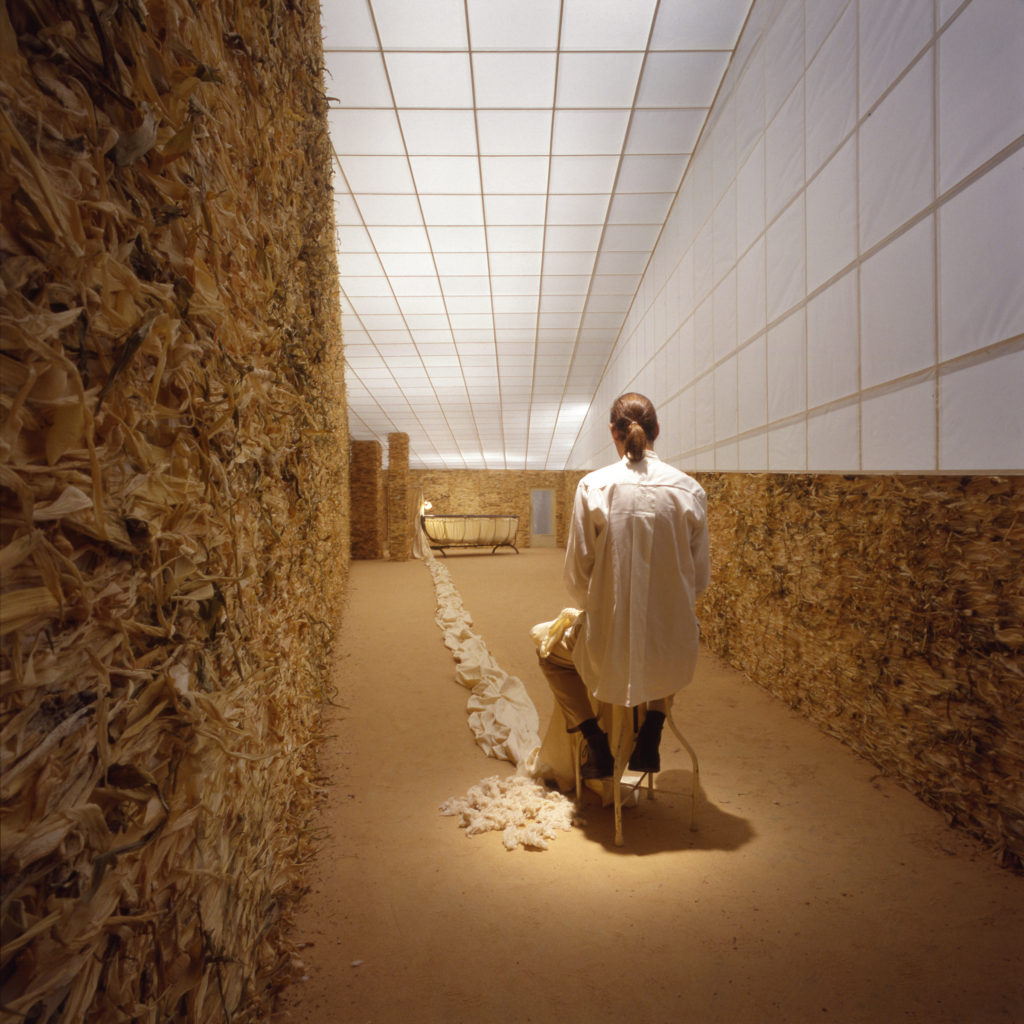
1992: Jimmie Durham’s On the Banks of the Ohio, in Will/Power
This quotation from the Will/Power catalogue sums up the peculiar qualities of gallery B better than any other description I have read:
From his initial site visit, [Jimmie Durham] was drawn to gallery B with its triangular floor plan and erratic ceiling heights, which make it simultaneously intimate and expansive.
– Will/Power catalogue (1993) 11.
1995: Chris Marker Silent Movie
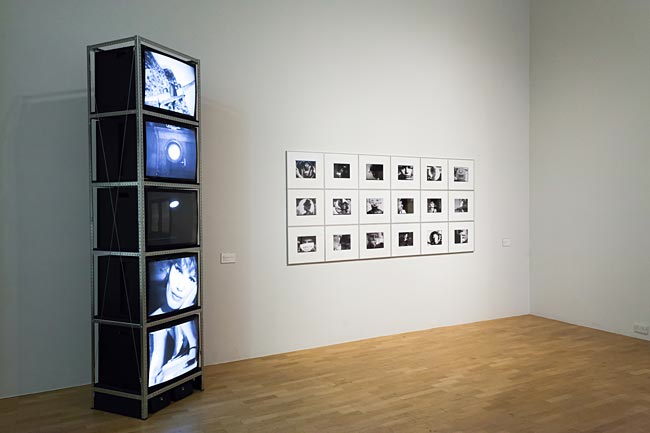
1997: Beverly Semmes Stuffed Cat
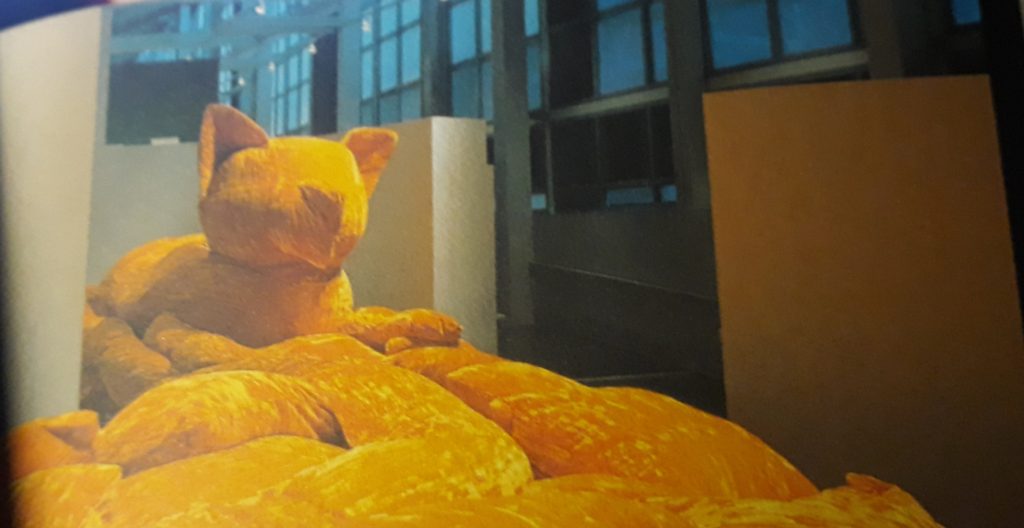
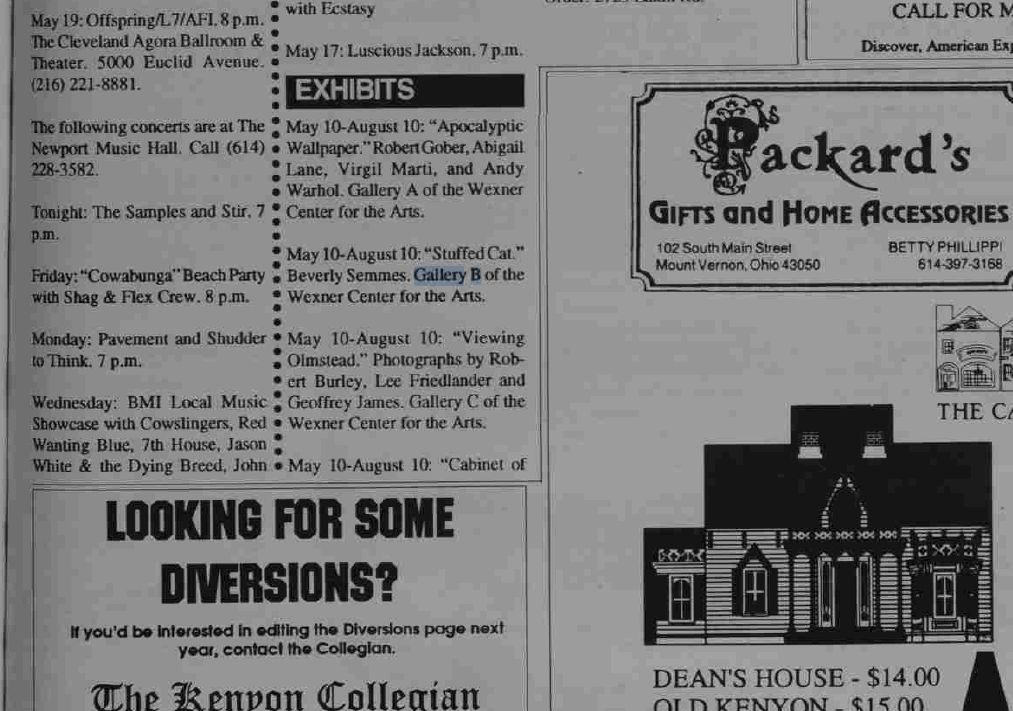
The below photos were sent to the gallery B side by the artist herself – thank you Beverly Semmes – it is amazing to see the full-scale work filling the gallery!
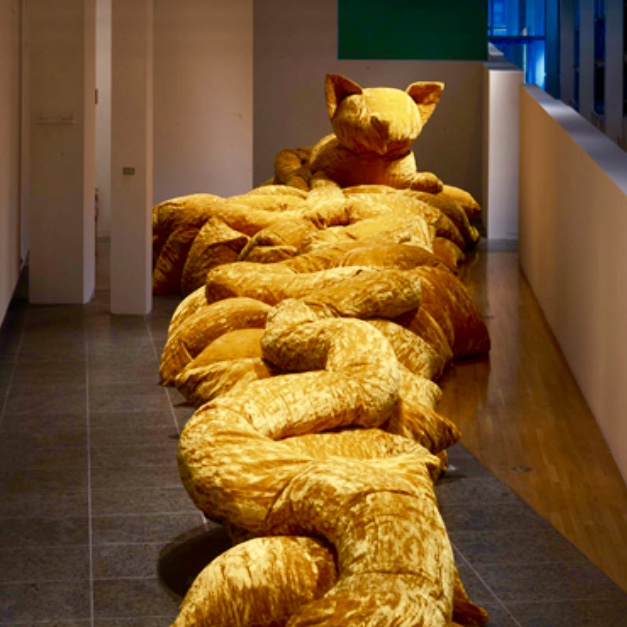
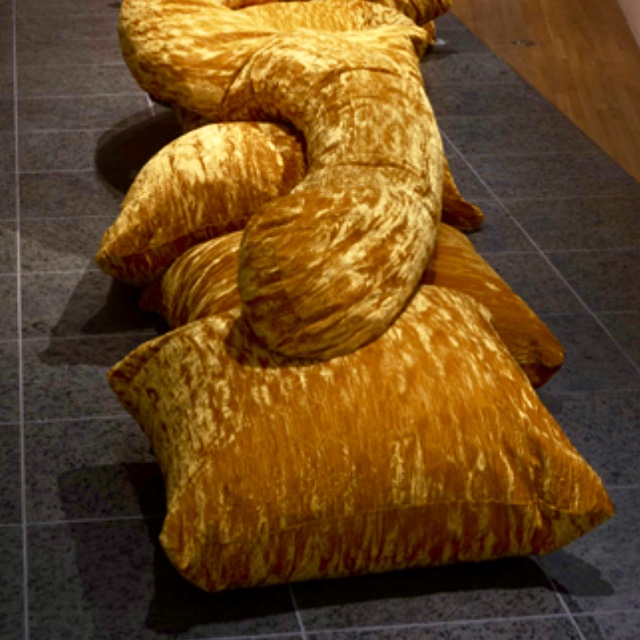
1998: Eva Hesse: Area
This is not a photo of gallery B, but of Hesse’s work represented in two books (click images for links). Can you spot the difference?
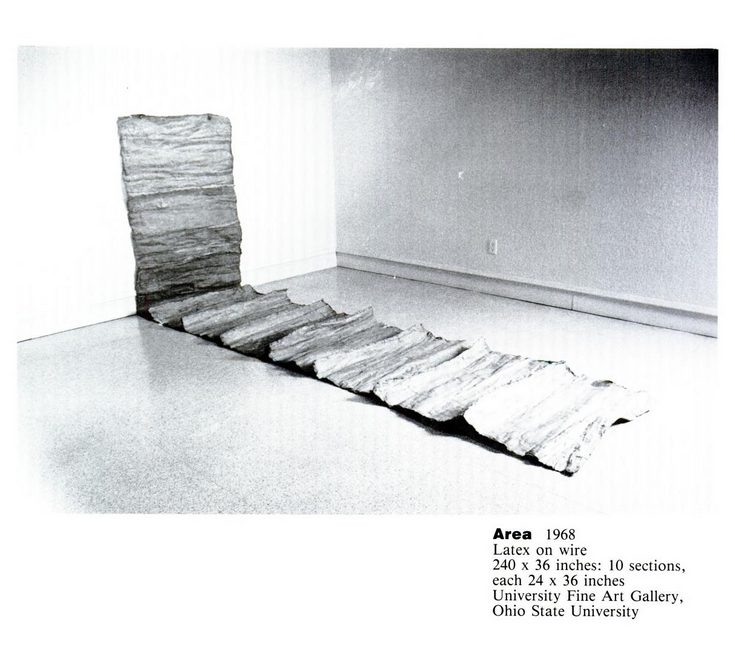
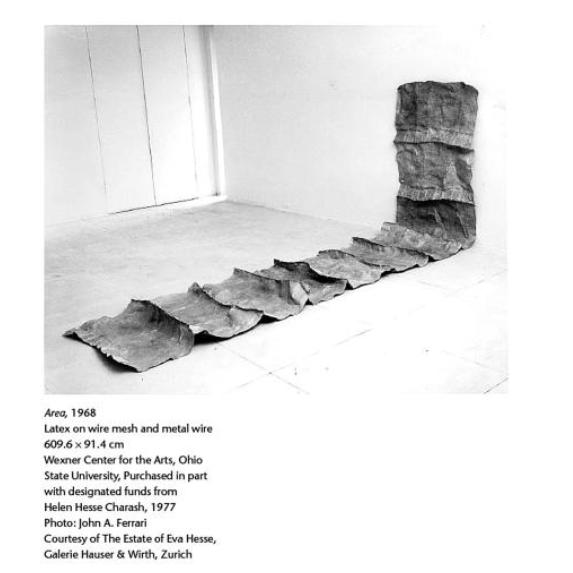
1999: Thomas Patin Discipline and Varnish: Rhetoric, Subjectivity, and Counter-Memory in the Museum, cover image
Not an exhibition, but a book cover, and the only one I know of that stars gallery B! Now I have to find out which exhibition this was…
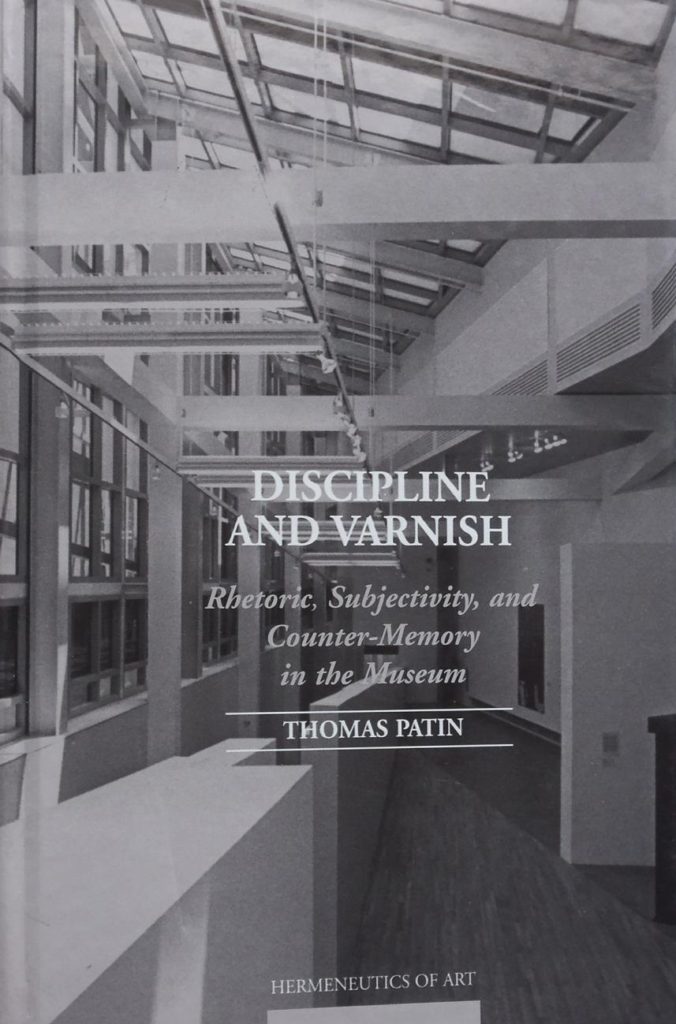
2002: Mood River
2006: Part Object/Part Sculpture
This was the first exhibition I saw at the Wex. I was on my campus visit and managed to find a short break between interviews to run around the galleries. I remember seeing Cy Twombly’s pan-pipe sculpture siting on a plinth beneath Duchamp’s floating hat-tack. It is hard to separate my memory from the Louise Lawler glass paperweight work that she made from a photo of the very same installation.
2006: Louise Lawler: Twice Untitled and Other Pictures (looking back)
Here the problem is remembering what works by Lawler were included in gallery B. I wonder if the Twombly paper-weight was here?
2007: Chris Marker Staring Back
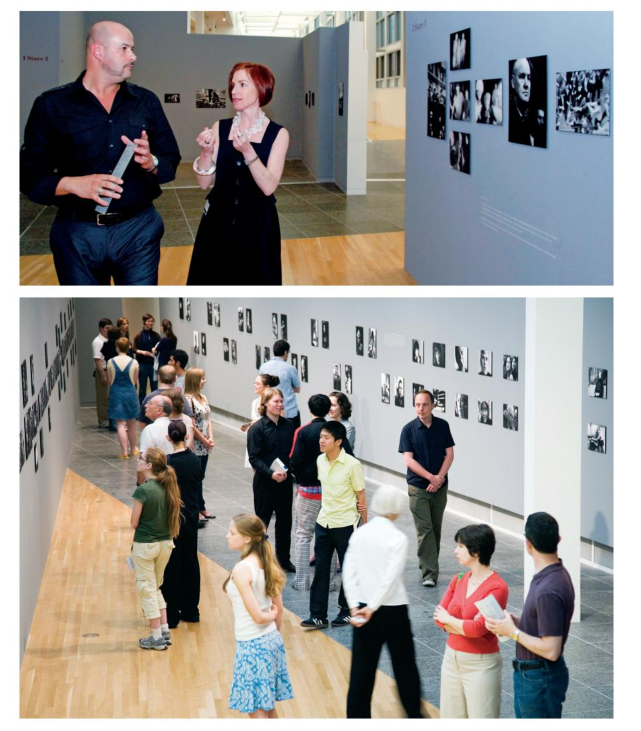
This is the most memorable exhibition I have visited in gallery B. The music! I have the list of track from the gallery guide tucked away in my copy of the (incredible) catalogue. Click on the images to find some of the links to the music.
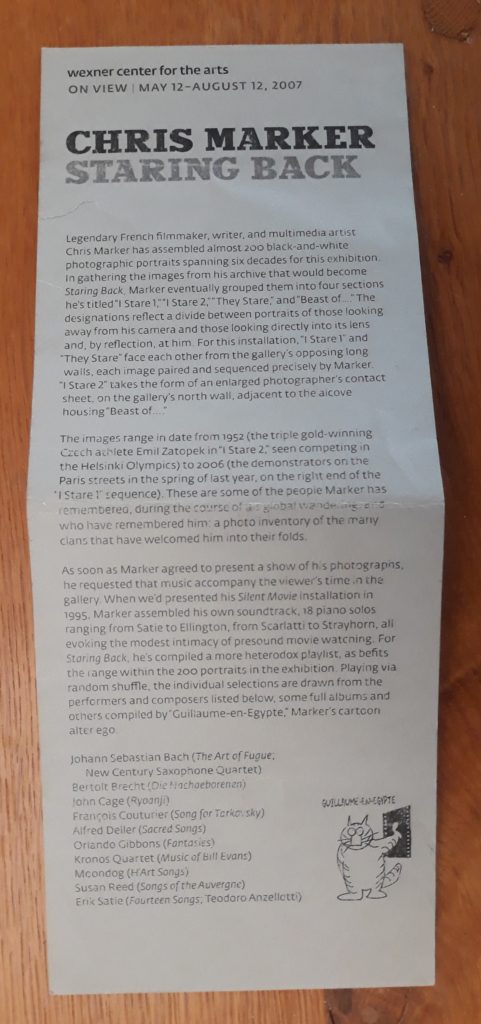
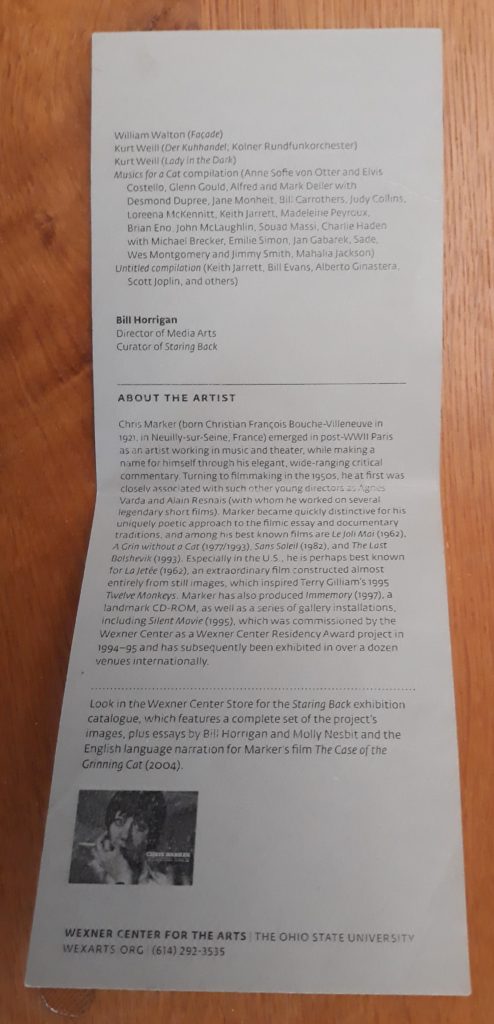
2007: William Wegman: Funney/Strange
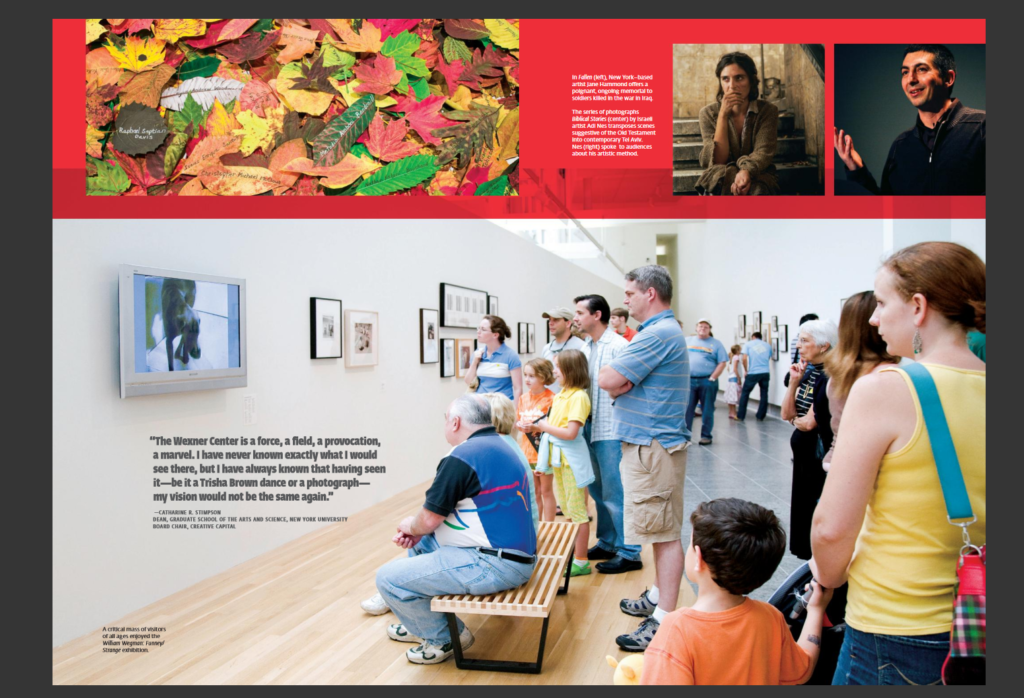
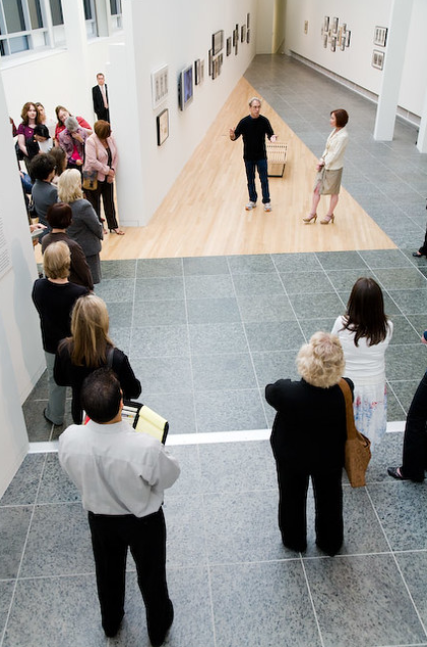
2008: Jane Hammond: Fallen
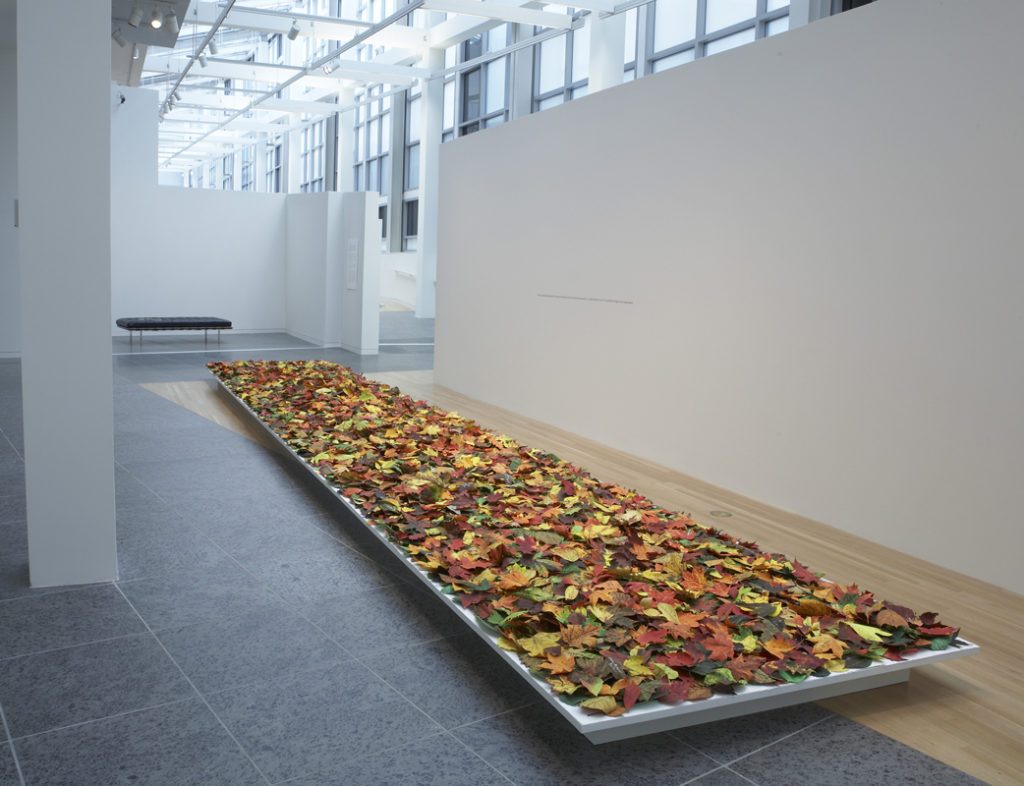
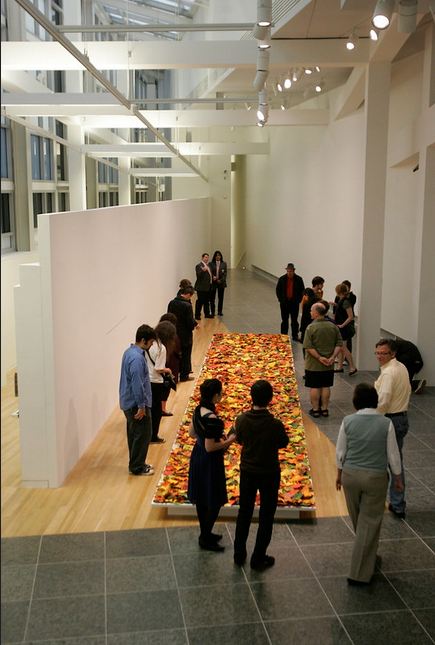
2010-11: Gustavo Gody’s Fast-formal Object: Flayed White, in Six Solos
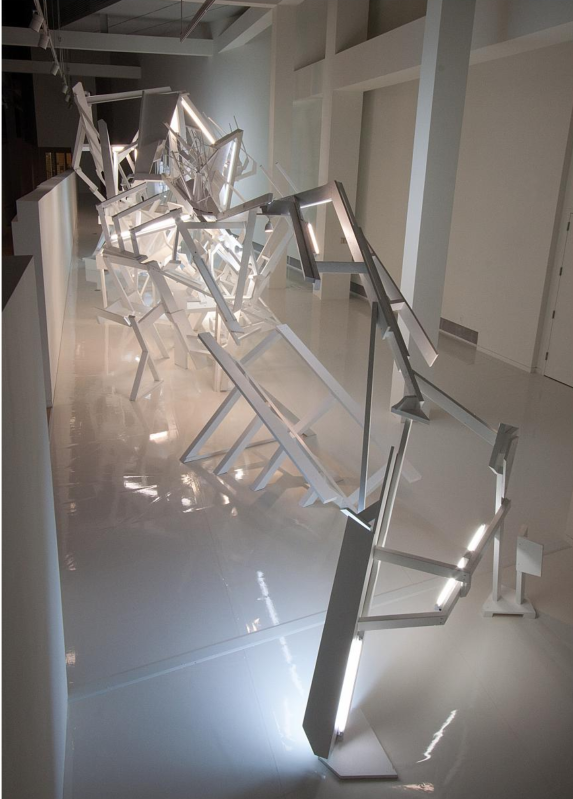
2011: Alexis Rockman A Fable for Tomorrow
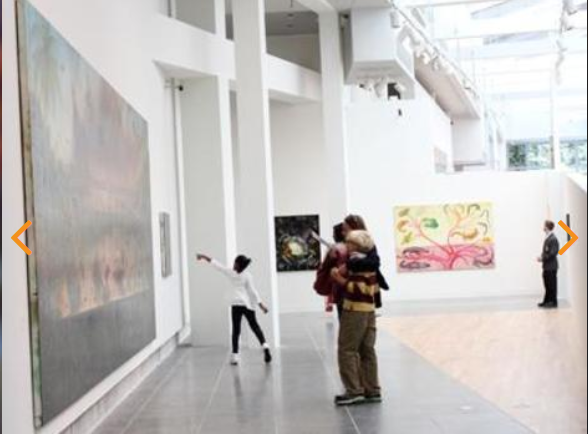

2013: Josiah McElheny: Towards a Light Club
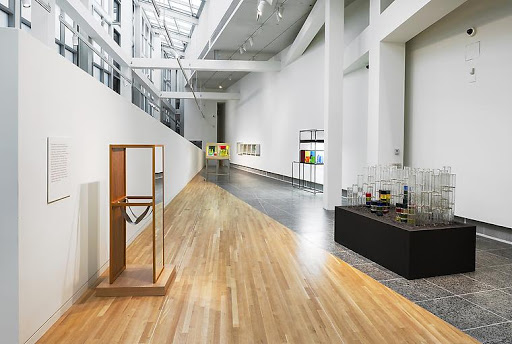
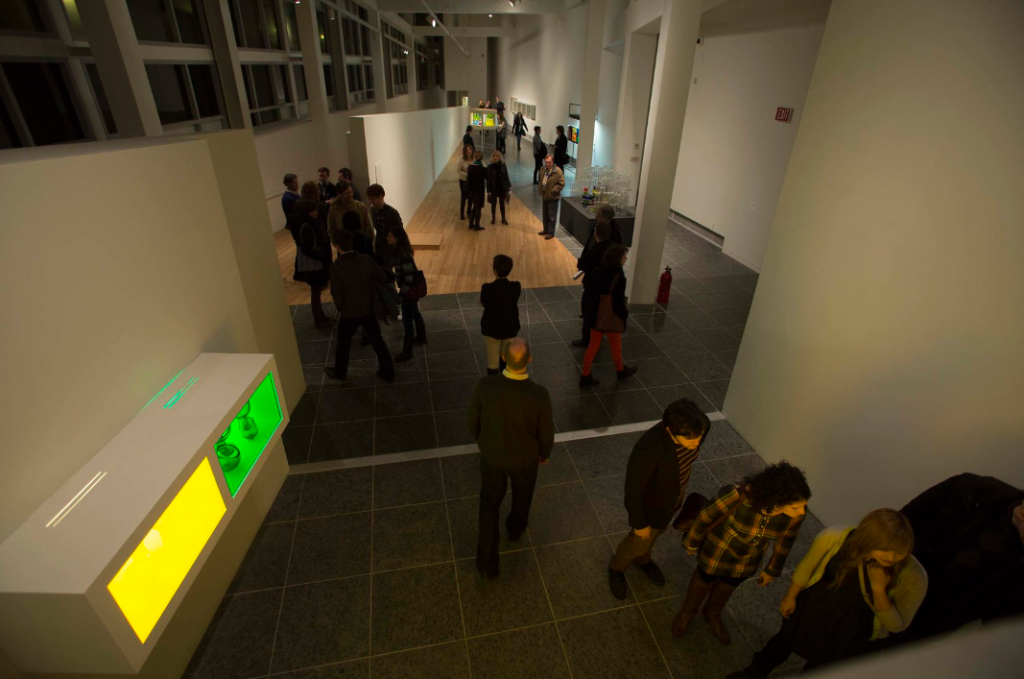
2013: Blues for Smoke
Dear Wexner Center for the Arts Film/Video Department,
I am writing this post for the gallery B side as an open letter to you in request that you show Wu Tsang’ 2012 short film For how we perceived a life (Take 3) as part of your online programming.
Back in Fall 2013, during the visiting exhibition Blues for Smoke, Gallery B housed Carrie Mae Weems’ photographic series Family Pictures and Stories 1982-4) along one wall, and a selection of Mark Morrisroe’s bleached prints and negative sandwiches from the same decade on the other wall. As the end of the gallery, four monitors screened a selection of films and videos, including Richard Pryor stand-up routines, music documentaries and episodes of The Wire (2002-8).

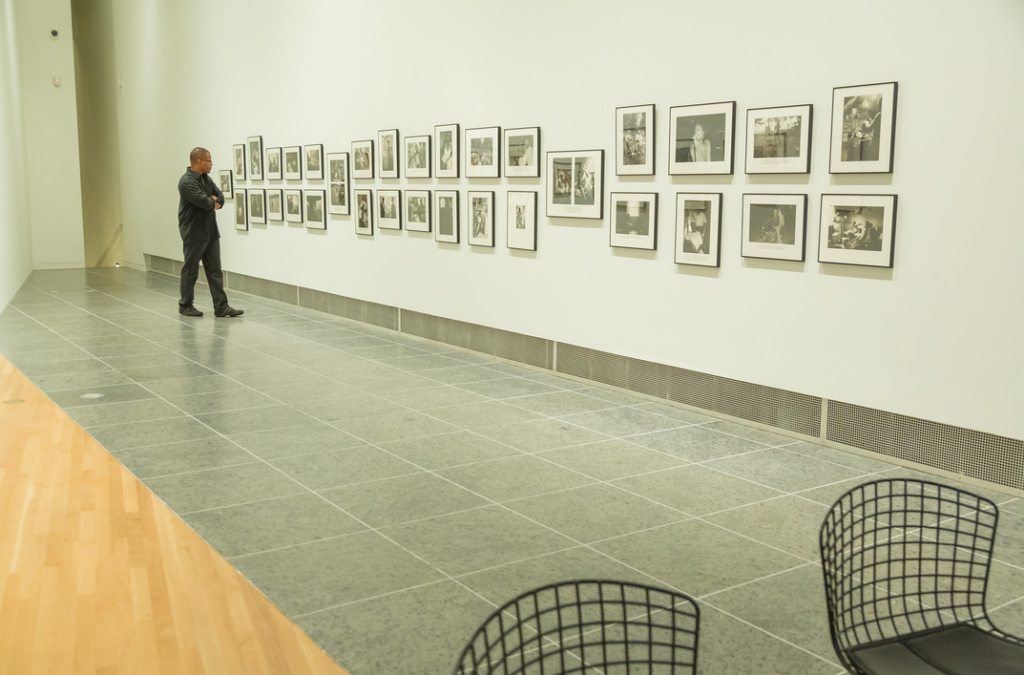
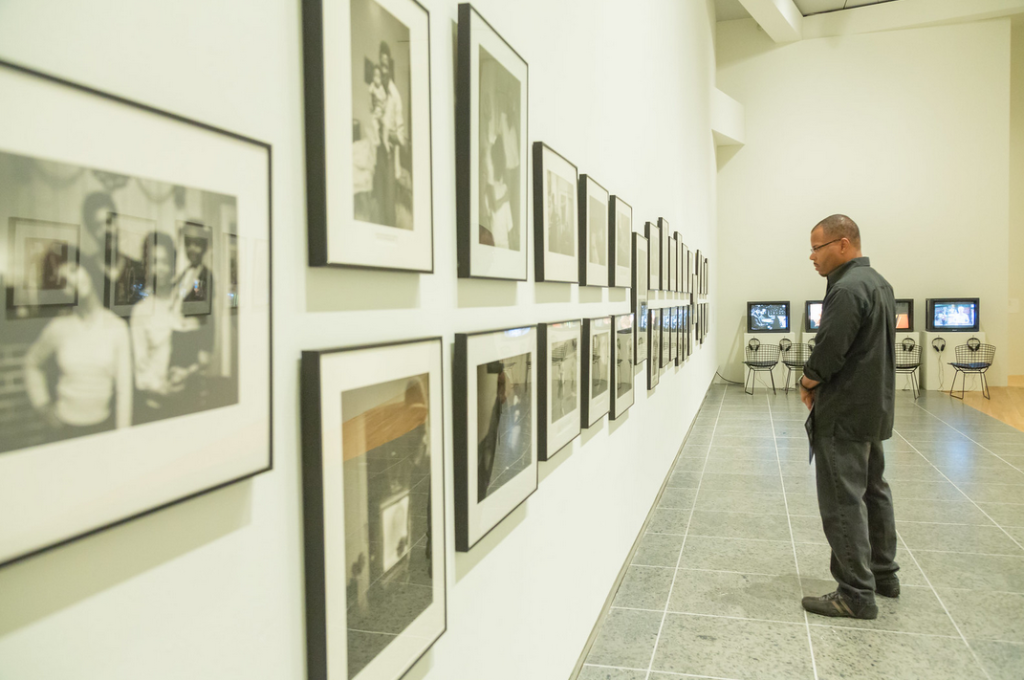
In his contribution to the exhibition catalog called ‘The Wire and the Blues’, participating artist Glenn Ligon juxtaposes the opening scene from the first episode of the TV series with a moment in Jennie Livingston’s Paris is Burning (1990), which, as you know, is a documentary about the New York City voguing subculture of the 1980s.
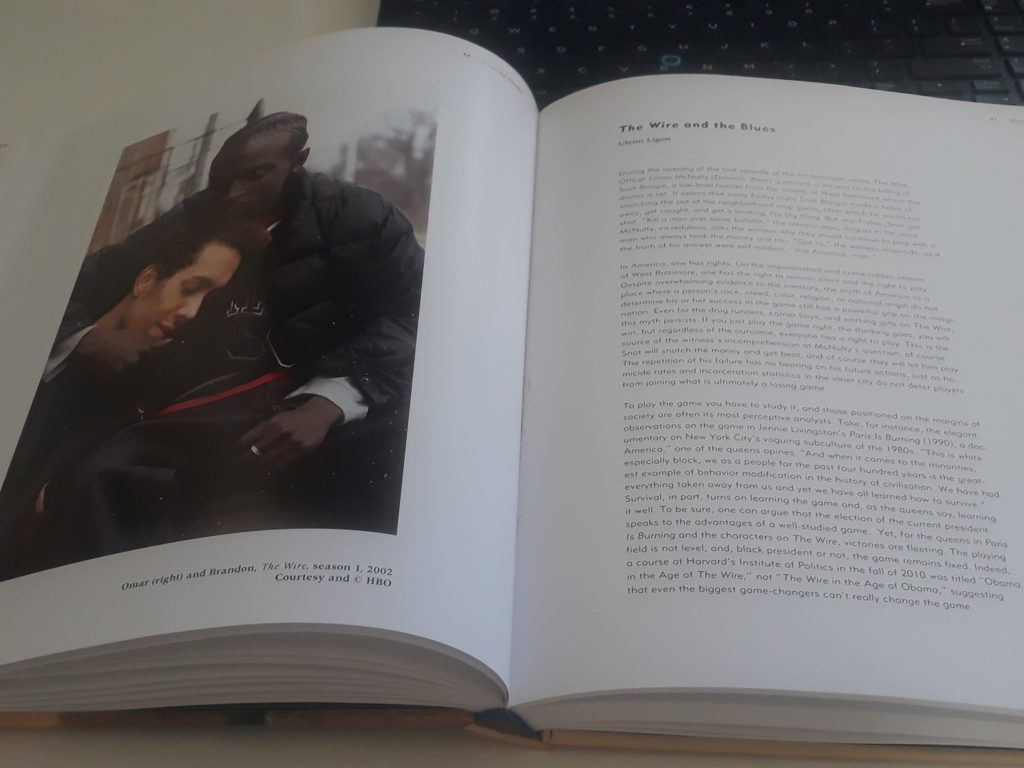
This is white America. And when it comes to the minorities, especially black, we as a people for the past four hundred years is the greatest example of behavior modification in the history of civilization. We have had everything taken away from us and yet we have all learned how to survive.
Now I know that you have screened Paris is Burning before, along with a panel discussion in a program called Topics in Black Masculinity: The Fierceness of Black Sexuality, Black Gay Identity, and Black Sexual Freedom back in February 2018. However, did you remember that this film had a presence at the Blues for Smoke exhibition, and not only in of Mark Bradford’s epic 2010 collage Paris is Burning.

At the slender lower entrance to gallery B, the Wu Tsang’s film Mishima in Mexico” (2012) was shown on loop.
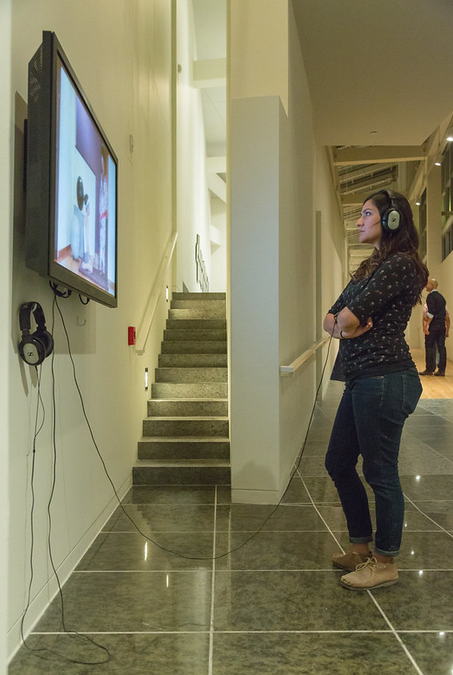
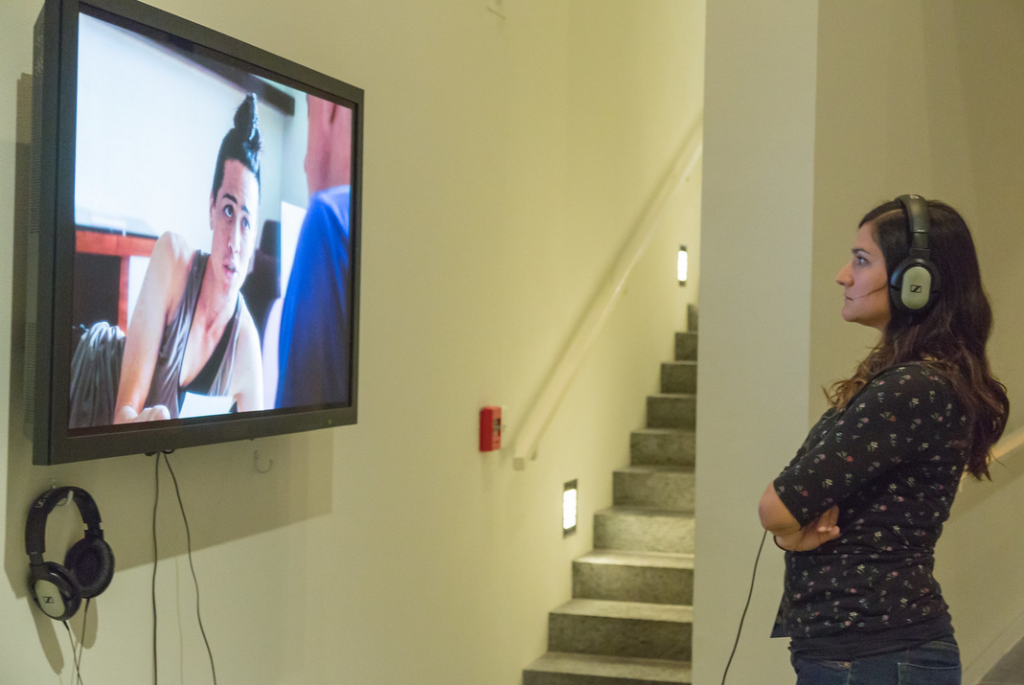
However, in the catalog and its checklist, the film by Tsang included in the exhibition was For how we perceived a life (Take 3) (2012), a film that embodies an extended quotation from Paris is Burning, including the passage quoted by Ligon.
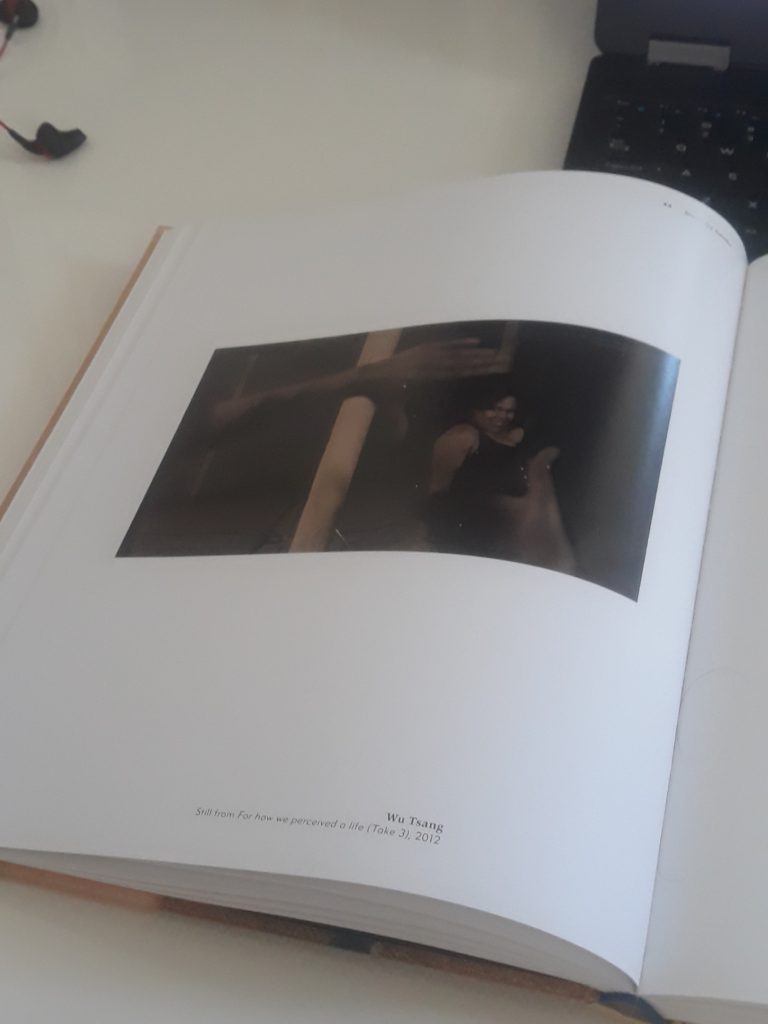
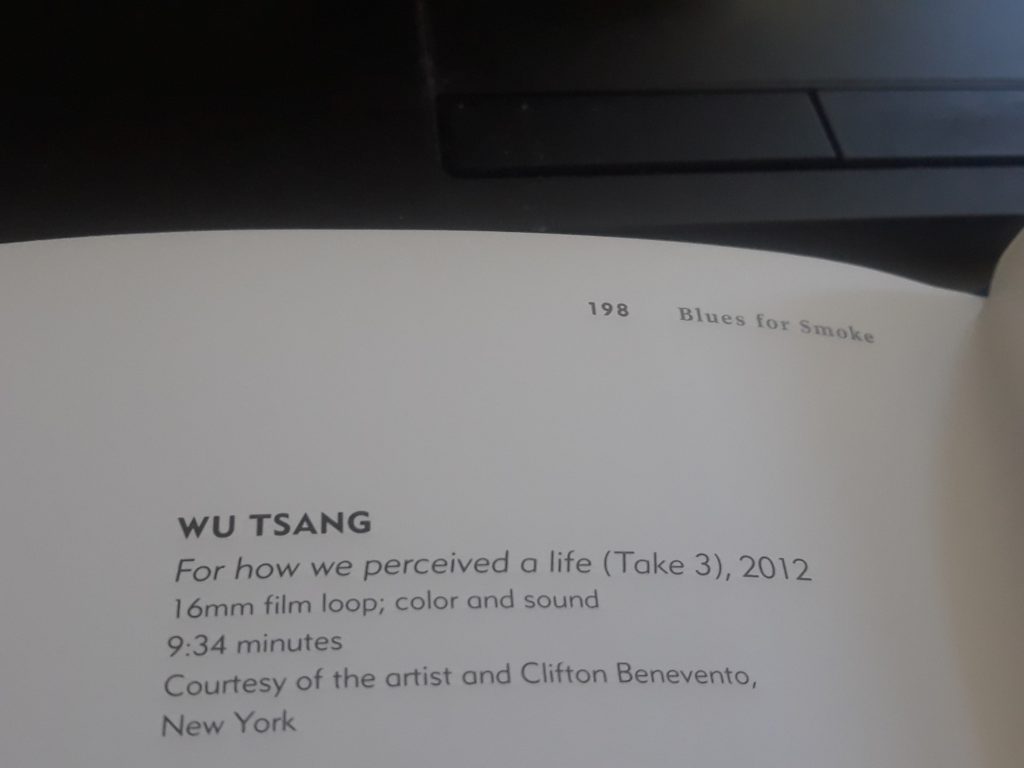
While you would have to ask your colleagues in the Exhibitions department (or the artist or the exhibition curator Bennett Simpson) why the film pictured and listed in the catalog was changed (both at the Wex and, as far as I can tell at its other venues), I am writing to suggest to you that now, as the Wexner Center’s programming gives a wider audience to often marginalized creators, would be a vital moment for the Wexner to show Tsang’s original film on its online platform. As Tsang has in the past been a recipient of postproduction support from the Wexner Center’s Film/Video Studio Program (for their 2012 film Wildness), showing For how we perceived a life (Take 3) would further highlight the Wex’s commitments to diverse voices and visions, past, present and future.
Thank you for your time and consideration.
Best wishes, Minus Plato
2018: Mickalene Thomas I Can’t See You Without Me
I can’t recall too many moving image works installed in gallery B, but even if I could, I don’t believe any could compete with the intensity of Mickalene Thomas’ 12 monitor video installation Me as Muse (2016) included the 2018 exhibition Mickalene Thomas: I Can’t See You Without Me.
For the earlier (2017-2018) exhibition Trigger: Gender as a Tool and a Weapon at the New Museum – curated by now Director of the Wex, Johanna Burton – Me as Muse was set in a wide corner of a darkened gallery, reflected by the shiny concrete flooring.
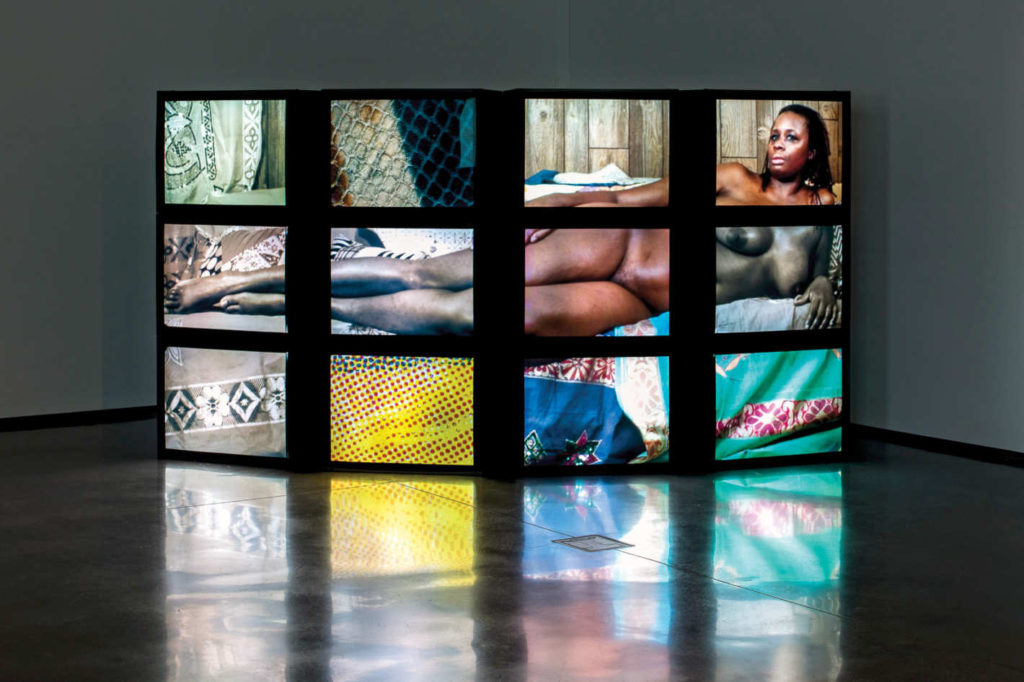
Yet at the Wex, the narrowing walls of gallery B directed all of our attention to this work in an intense framing of light and space, while the flooring panels directly mirrored the monitors.
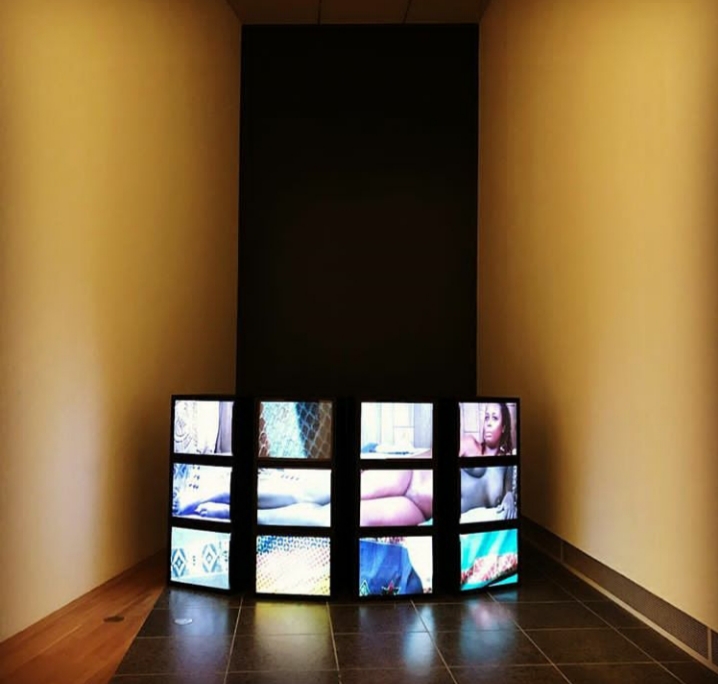
In his essay (‘Mama as Muse’) in the exhibition catalog, Antwaun Sargent focuses on Thomas’ work starring the artist’s mother, Mama Bush. However, his opening quotation from Audre Lorde’s 1982 autobiography Zami: A New Spelling of My Name – “To whom do I owe the woman I have become?” – while framing the analysis of ‘mama as muse’, also redirects attention to the self-presentation and agency of the artist herself. This redirection of attention was reflected by the installation at the Wex, which literally stopped you in your tracks at the narrowing end of gallery B.
2019: John Waters: Indecent Exposure
At idle moments during this endless lockdown, have you ever imagined what the artworks in all those museums storage units around the world are getting up to right now? Of course, that troublemaker John Waters has.
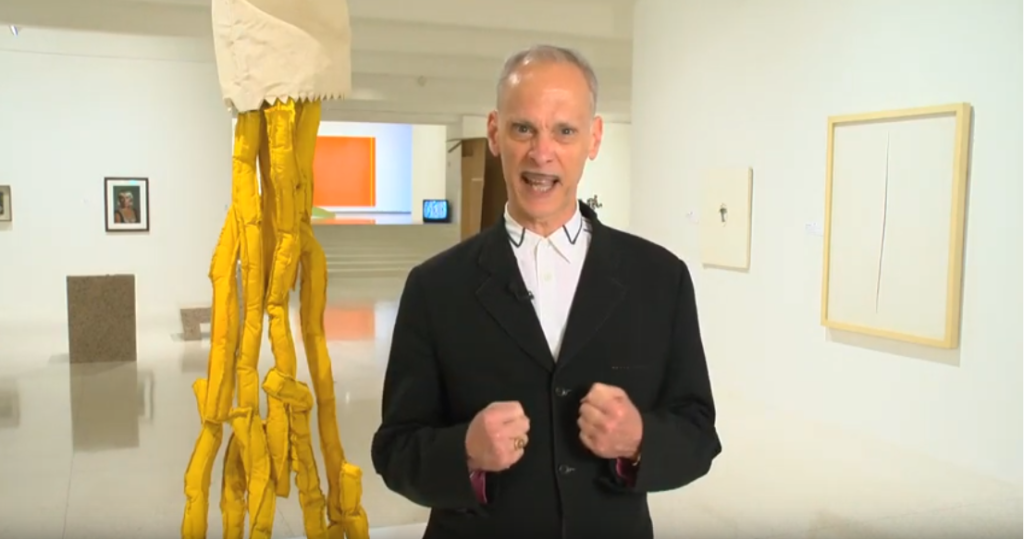
Writing on the Walker Art Center website back in 2011, he mused:
Are prints, sculptures, paintings and photographs relieved to be in museum storage where they don’t have to shine, “art-off”, risk exposure to light? Or are they happy when they have to “work”? Get along with each other in public? Hear sometimes stupid comments from hostile museum-going amateurs? Publicly humiliate themselves by being forced to live up to their auction prices? Who should room together in the world of contemporary art? Can a Russ Meyer photograph go to sleep in the same gallery as an Yves Klein blue chip masterpiece? Certainly, Sturtevant is secure enough to be hated, but is Anne Truitt? Video art has “street cred” these days but can it ever catch up with a John Currin painting in art-history references, even if they’re embraced and mocked? Who’d copy from Richard Prince? Who’d be sloppier to live with than Mike Kelley? And better yet, who’d ruin decoration more than Christopher Wool? Suppose an “art-terrorist” like Gregory Green was hiding amongst us? Do we snitch or shiver in welcome artistic fear? Would Fred Sandback approve of the damage his fellow roommates have caused or would he think they were trying too hard? Can artwork sexually attract each other? Does minimalism make pop horny?
Combining Waters’ reference to Anne Truitt’s sense of worth with minimalism’s libido reminded me of his work Secret Movie which graced gallery B during his exhibition Indecent Exposure. Here is an austere photograph of the work from the catalog.
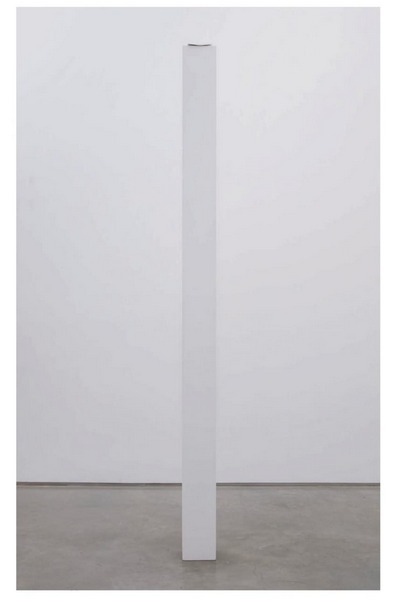
Although you get a better sense of the work from this description of the in a review of the Baltimore installation of the show by Brian McCabe:
To add a level of titillation and intrigue to this post, I want to share with you a moment when the ‘secret’ was revealed as recorded on the Instagram account of one zane.a.miller. I am not going to play spoilsport here, so if you really need to know the secret, click on either of the images below for al to be revealed.
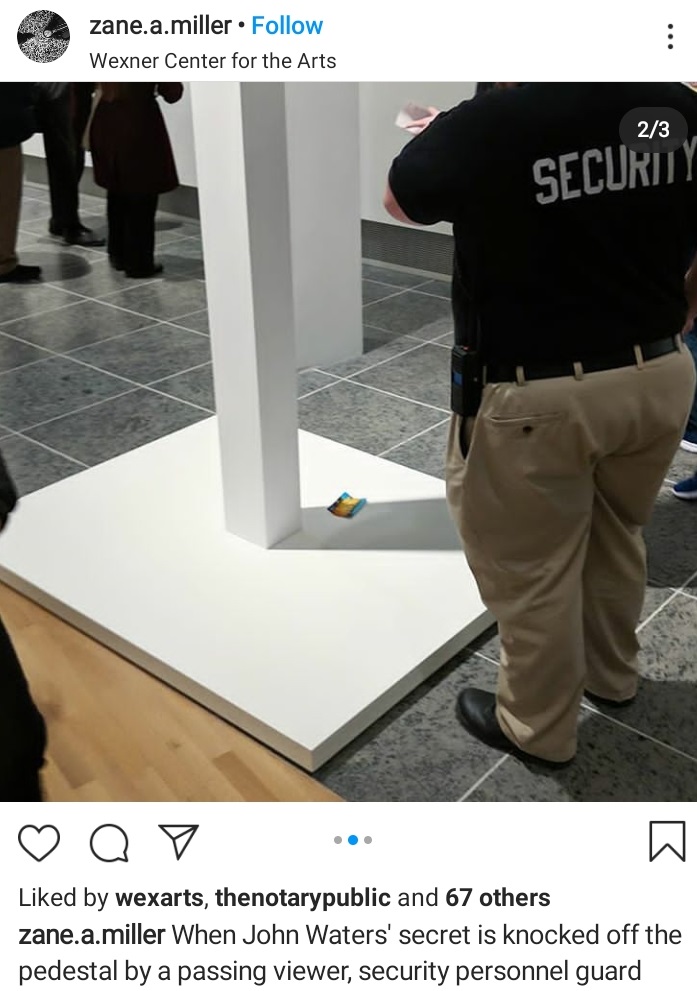
2019: Cecilia Vicuña: Lo Precario/The Precarious
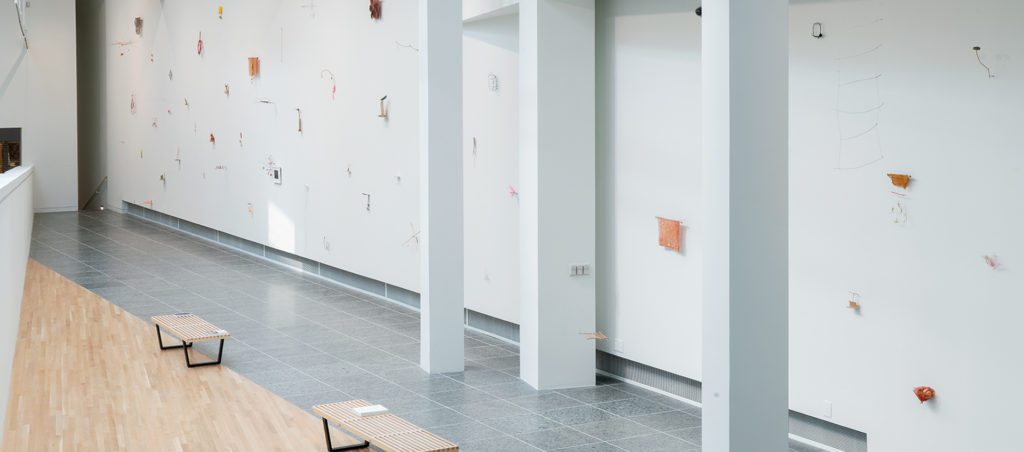
2019: Jenny Holzer’s Inflammatory Essays (1979–82), in HERE
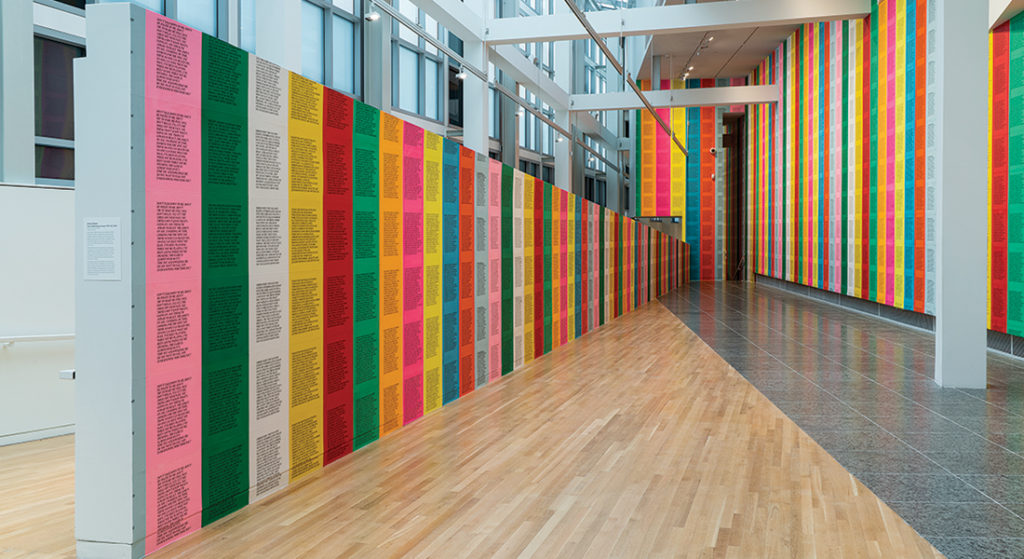
2020: Sadie Benning Pain Thing
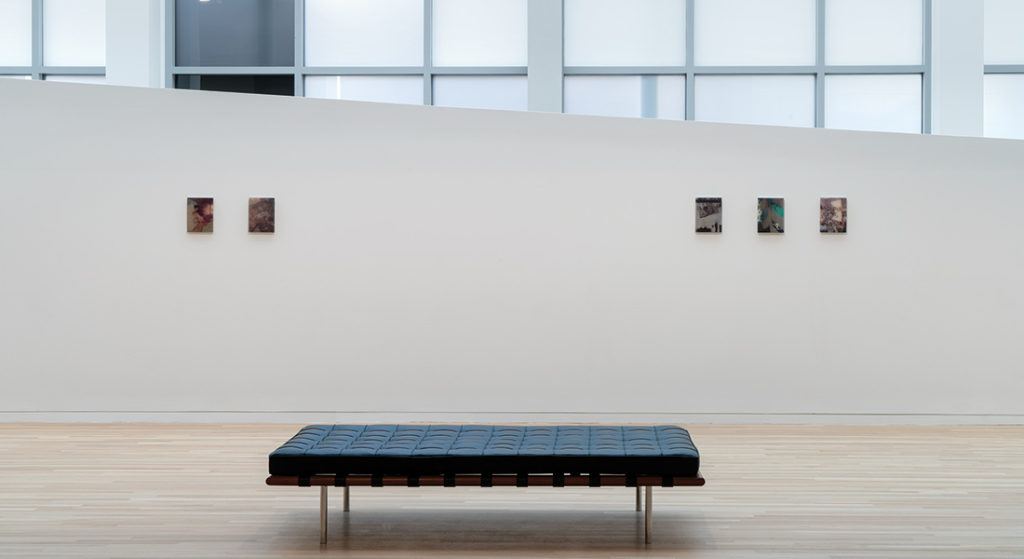
About
the gallery B side is an unofficial online community fanzine for gallery B at the Wexner Center for the Arts in Columbus, Ohio. As a way to keep the space in our minds during its closure amid the COVID-19 crisis, this fanzine is a space for photos, memories, stories and general expressions of love for this quirky slice of gallery space.
Please send any submissions for the gallery B side to minusplato@gmail.com.


